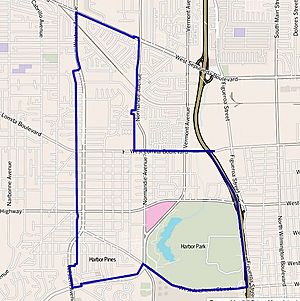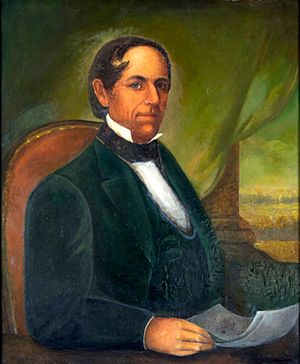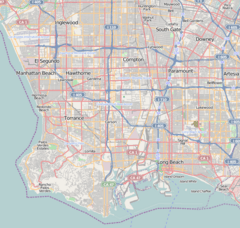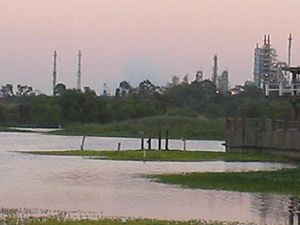Harbor City, Los Angeles facts for kids
Quick facts for kids
Harbor City
|
|
|---|---|

Harbor City as outlined by the Los Angeles Times
|
|
| Country | United States |
| State | California |
| County | Los Angeles |
| City | Los Angeles |
| Named for | Nearby ports of Los Angeles and Long Beach |
Harbor City is a lively neighborhood in the South Bay area of Los Angeles, California. It is home to over 36,000 people. This area was once part of a large Spanish land grant called Rancho San Pedro.
Harbor City joined Los Angeles to help connect the bigger city with the important port towns of Wilmington and San Pedro. Today, the neighborhood has two high schools and seven other schools. It also features the Ken Malloy Harbor Regional Park and two other parks. There is even a Kaiser Permanente hospital here. Many people in Harbor City graduate from high school, more than the average for Los Angeles.
Contents
Exploring Harbor City's Location
Harbor City is surrounded by other parts of Los Angeles and nearby cities. To the north, you'll find Harbor Gateway. To the east are West Carson and Wilmington. South of Harbor City are Wilmington and San Pedro. Finally, to the west are Torrance and Lomita.
The neighborhood's borders are West Sepulveda Boulevard in the north. Western Avenue and the Harbor Freeway form the eastern edge. West Anaheim Street and Palos Verdes Drive mark the southern boundary. The western side borders Lomita and Torrance.
Who Lives in Harbor City?
In 2000, about 23,561 people lived in Harbor City. This means there were about 9,127 people per square mile. By 2008, the population grew to an estimated 36,040. The average age of people in Harbor City is 40. Many young people, from birth to age 34, live here.
Harbor City is known for its many different cultures. In 2000, nearly half the people (48.1%) were Latinos. About 25.1% were non-Hispanic whites. Asians made up 14.1% of the population, and Blacks were 10.7%. Many residents (36.2%) were born outside the United States. Most of these came from Mexico and Korea.
The average household income in Harbor City in 2008 was about $55,454. More than half of the homes (54.4%) were rented, while the rest were owned by the people living in them.
A Look Back at Harbor City's Past

For thousands of years, the Tongva–Gabrieleño Native Americans lived in the Los Angeles area. They were the first people to call this land home. Archeological sites show that people lived here as far back as 8,000 to 15,000 years ago. The Tongva first met Europeans in 1542 when a Portuguese explorer named João Cabrilho arrived. He was the first to write about them.
The Tongva had a large settlement called Shwaanga in the Harbor area. The water in Machado Lake was so clean that it was called "Sweet Water." The Tongva enjoyed a good life with plenty of food, water, and resources.
Spanish and Mexican Rule
Harbor City was originally part of a huge land grant called Rancho San Pedro. In 1784, King Carlos III of Spain gave this land to Juan Jose Dominguez. During the Spanish and Mexican periods of Alta California, parts of this rancho were divided and sold. After the Mexican–American War ended in 1848, many rancho lands were bought by American settlers.
Joining Los Angeles
Around the early 1900s, leaders in Los Angeles decided it would be good for the city to control the port areas directly. At that time, San Pedro and Wilmington were independent cities. They were also the main locations for what would become the Port of Los Angeles.
Los Angeles leaders believed that direct control of the port would help San Pedro and Wilmington get more money. In return, Los Angeles would earn more from the growing port trade. San Pedro and Wilmington were not sure about joining at first. So, in 1906, Los Angeles bought a long, narrow strip of land. This land connected South Los Angeles to San Pedro. They named these new areas Harbor Gateway and Harbor City.
City leaders then threatened to build a new port in Harbor City if San Pedro and Wilmington did not agree to join. By 1909, both towns agreed. In return, Los Angeles decided to keep Harbor City as a land-locked part of the main city. This connected the big city to its new ocean trading centers.
Important Places in Harbor City
Harbor City is home to the Kaiser Permanente Medical Center. This hospital and its medical buildings are located along Pacific Coast Highway (SR 1). It is between Normandie and Vermont Avenues. The hospital is right across from Ken Malloy Memorial Park.
Learning in Harbor City
By 2000, about 18.1% of Harbor City residents aged 25 or older had finished a four-year college degree. This number is about average for Los Angeles.
Schools in the Area
Here are some of the schools located within Harbor City:
- Nathaniel Narbonne Senior High School, part of LAUSD, at 24300 South Western Avenue.
- George S. Patton Continuation School, also LAUSD, at 24514 South Western Avenue.
- President Avenue Elementary School, LAUSD, at 1465 West 243rd Street.
- The Pines Christian, a private elementary school, at 25200 South Western Avenue.
- Normont Elementary School, at 1001 West 253rd Street.
- Harbor Church Schools, a private elementary school, at 1716 West 254th Street.
- Harbor City Elementary School, LAUSD, at 1508 West 254th Street.
- Gateway Christian School, a private school, at 25500 Vermont Avenue.
Some schools that serve Harbor City students are actually in the nearby city of Wilmington:
- Harbor Teacher Preparation Academy, an LAUSD high school, at 1111 Figueroa Place.
- Los Angeles Harbor College, a public community college, also at 1111 Figueroa Place.
Local Libraries
The Los Angeles Public Library runs the Harbor Gateway-Harbor City Branch Library. It's a great place to find books and learn new things.
Fun and Parks in Harbor City
Harbor City offers several places for recreation and outdoor fun:
- Harbor City Park is located at 24902 Frampton Avenue, near Lomita Boulevard. This park includes the Harbor City Recreation Center and the Harbor City Childcare Center.
- The Harbor City Recreation Center has a gymnasium that can also be used as an auditorium. It offers a lighted baseball diamond, lighted indoor and outdoor basketball courts, and a children's play area. There's also a community room, picnic tables, a senior center, and a lighted soccer field. The center also serves as a stop-in point for the Los Angeles Police Department.
- The Ken Malloy Harbor Regional Park on South Normandie Avenue is a large park with many features. It has barbecue pits, a lighted baseball diamond, and a bicycle path. You can also find the Machado Youth Camp campground, a children's play area, hiking trails, and a jogging path. The park also has a lake (though fishing is not allowed) and a lighted soccer field.
Famous People from Harbor City
Many talented people have lived in Harbor City:
- Bo Derek (born 1956), a well-known actress.
- Daniel Munyer (born 1992), an NFL football player.
- Merrill Moses (born 1977), an Olympic water polo player.
- Jon Singleton (born 1991), a Major League Baseball player.
- Stephen Thompson Jr. (born 1997), a basketball player.
- Jennifer Tilly (born 1958), an actress and professional poker player.
- Brian Welch (born 1970), a musician and guitarist for the band Korn.
- Jon Bunch (born 1970), a singer and songwriter for the band Sense field.
See also
 In Spanish: Harbor City (Los Ángeles) para niños
In Spanish: Harbor City (Los Ángeles) para niños



